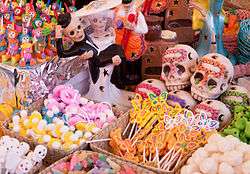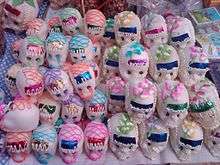Alfeñique

An alfeñique is a confection molded from sugar paste. The design and construction of these figures can vary from region to region. Today, alfeñique figures, especially calaveras, are widely created in Mexico for the Day of the Dead celebrations in November.
History
Alfeñique are folk art objects made from a sugar paste, originating in Italy where figurines were made from sugar for religious decorations. They became popular in Spain, wherefrom they were eventually brought to Mexico with Catholicism, where they became a part of Day of the Dead celebrations, starting around the 17th or 18th century.[1] Alfeñique, whose name is from Arabic was used to replace the Aztec tradition of making figurines of amaranth for altars. The Spanish conquistadors brought sugar cane, which became the main ingredient in the making of these figurines which continues to this day.[2] During the colonial period, figures of sheep made with this were popular.[3]
Today, the main production center for alfenique figures are Toluca, San Miguel de Allende and Guanajuato. Today, the paste is used to form hundreds of types of shapes which include rabbits, lions, ducks, doves, cows, bulls, donkeys, pigs, frogs, horses, deer, angels, skulls and coffins.[3] The art form has taken on more elaborate sculptures that involve more sophisticated and modern techniques that there are now encyclopedic volumes on how to create them for all different occasions, apart from Day of the Dead celebrations.[4] There are regional fairs and events that celebrate this art form, including ones in Toluca, Mexico State and in Leon, Guanajuato.[5][6]
Process

The paste is prepared by mixing powdered sugar with chautle, a vegetable adhesive and lemon. Egg whites are beaten separately then folded into the sugar. Vegetable dyes are added for color. The unworked portion is covered with a damp cloth to keep it from hardening. Molds are prepared by carefully cleaning them, then dusting them with flour so the sugar mixture does not stick. The sugar paste is flattened into thin circles which are pressed into the molds, then left to dry for 24 hours[3]
The two halves of the figure are then taken from the molds and joined together with more sugar paste, slightly thinned with water. This is left to dry again before decoration. Decorative elements can include cotton balls, sequins, sugar paste which is shaped and attached, plastic jewels and many other items[3]
Variations
The different regions make their alfeñique figures according to local traditions and ingredients. Many families have been involved in making figurines for generations and some use molds that go back just as far. Apart from their popularity during Day of the Dead celebrations, many families display the objects, particularly the skulls, in their homes.[2] In Oaxaca, they commonly take the shape of skulls, crowns, crucifixes, the dead and are made from crystallized sugar with honey in the center. In the State of Mexico, the most common objects are coffins, hearses, deer, sheep, angels, fruit, and skulls made of white sugar paste.[2] In Puebla, the most common objects are skulls and coffins and the main ingredients include almonds, peanuts and pumpkin seeds mixed with sugar and egg, in the style of an almond paste.[7]
Wenceslao Rivas Contreras
Toluca stands out for the quality of alfeñique. The most noted artisan is Wenceslao Rivas Contreras. He learned the craft from his parents and has improved upon it, specialized in large, abundantly decorated skulls. He also creates animals, coffins, hearts, boats, baskets, crosses, bouquets of flowers and variety of fruits.[3]
References
- ↑ "Mexican Sugar Skull". Thaneeya LLC. 2010–2011. Retrieved March 3, 2012.
- 1 2 3 María Teresa Pomar (2004). Alfeñique (in Spanish). México: CONACULTA. ISBN 970-35-0578-3.
- 1 2 3 4 5 Fernández de Calderón, Cándida, ed. (2003). Great Masters of Mexican Folk Art: From the collection of Fomento Cultural Banamex (2 ed.). Mexico City: Fomento Cultural Banamex, A.C. p. 503. ISBN 968 5234 09 4.
- ↑ de Alvarado, Marithé, ed. (2004). Arte Mexicano del Azúcar: Enciclopedia Ilustrado (in Spanish). Ciudad de México: McGraw Hill. ISBN 970-10-3596-8.
- ↑ "Feria Artesanal del Alfeñique, Mexico". Government of León, Guanajuato. Retrieved March 3, 2012.
- ↑ "Detallan actividades de la Feria del Alfeñique de Toluca". Mexico City: Milenio. September 28, 2010. Retrieved March 3, 2012.
- ↑ "El alfeñique". CAD SA de CV. 2010–2011. Retrieved March 3, 2012.